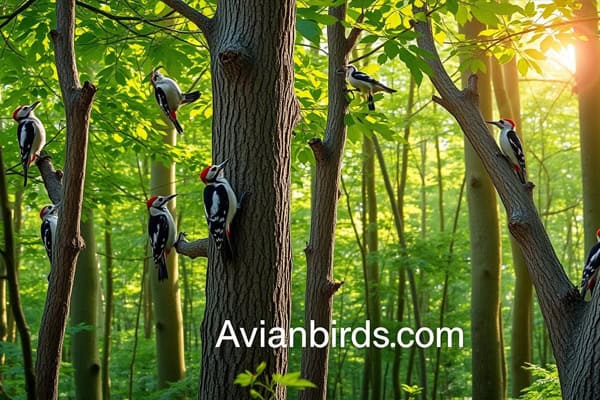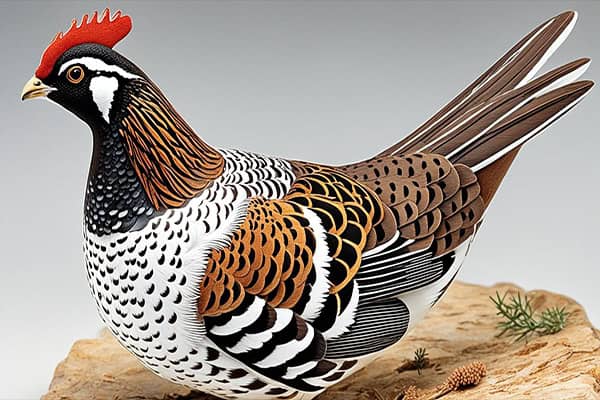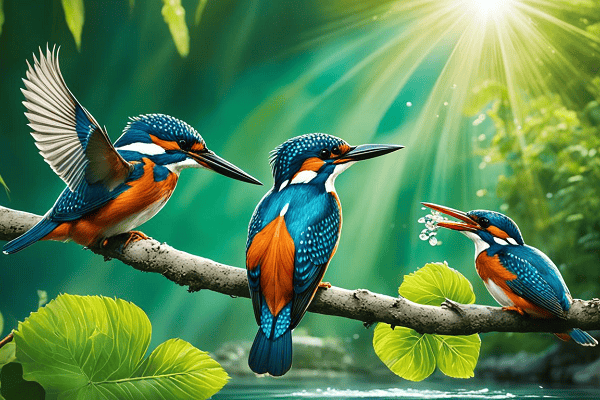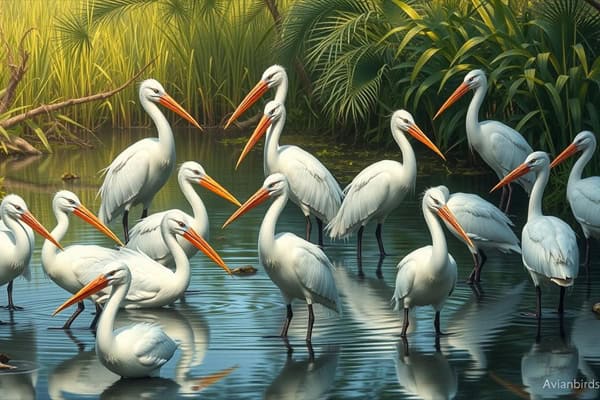Top 9 Types of Woodpeckers in Wisconsin (With Pictures)
Did you know Wisconsin has seven types of woodpeckers? These birds are key to our ecosystem and loved by birdwatchers. This guide will show you these beautiful birds’ special traits and homes. You’ll get lots of details, tips, and pictures to help you find them in the wild.
The Downy Woodpecker is common in Wisconsin all year, but the Black-backed Woodpecker is rare and found in the north woods. Knowing about Wisconsin’s woodpeckers improves birdwatching and helps us appreciate these amazing birds. Let’s explore Wisconsin’s woodpeckers together and learn how to spot them.
Introduction to Woodpeckers in Wisconsin
Woodpeckers are fascinating birds known for their unique behaviors and habitats. In Wisconsin, they add charm to the state’s diverse wildlife. Birdwatching in Wisconsin is an exciting experience for enthusiasts.
Wisconsin has over 32,900 miles of rivers and streams, plus 15,000 inland lakes. This variety creates great chances to see woodpeckers. They hunt for insects and help forests by breaking down trees.
Wisconsin is home to ten woodpecker species, like the Downy Woodpecker and Pileated Woodpecker. Each species adds something special to Wisconsin’s wildlife. Exploring the state’s forests and parks, you’ll be amazed by their adaptations and behaviors.
Learning about woodpeckers will make birdwatching even better. Whether you’re a seasoned birder or new, woodpeckers have something special for everyone. You’ll learn about their lives and how they help Wisconsin’s ecosystems.
Understanding Woodpeckers
Woodpeckers are part of the Picidae family. They have strong, pointed bills for pecking and drumming on trees. Their long tongues help them find insects in tight spots.
The Pileated Woodpecker eats mostly carpenter ants. It can eat up to 98 percent of its diet from these ants.
Woodpeckers do many things like nesting, vocalizing, and eating. They live in big areas, up to 200 acres. This shows how important it is to keep their homes safe.
Pileated Woodpeckers need dead trees and stumps for food and shelter. These trees also help other animals. Woodpeckers play a big role in keeping forests healthy.
It’s important to keep forests balanced. Some dead trees are good for woodpeckers. They provide homes and food.
Since 1966, Pileated Woodpeckers have been doing well. This is thanks to efforts to protect their homes. Learning about woodpeckers helps us see how they help our environment.
| Woodpecker Species | Habitat Range | Diet | Territory Size |
|---|---|---|---|
| Pileated Woodpecker | United States and Canada | 98% Carpenter Ants | 150 – 200 acres |
| Red-bellied Woodpecker | Southeastern United States | Insects and fruits | Varies |
| Downy Woodpecker | North America | Insects and seeds | Varies |
| Hairy Woodpecker | North America | Insects, especially beetles | Varies |
| Northern Flicker | North America | Ants, beetles, and seeds | Varies |
Common Characteristics of Woodpeckers
Woodpeckers have unique traits that help us identify them. They have chisel-like beaks for drilling into trees. Their stiff tail feathers help them stay stable while doing this.
Their zygodactyl feet are special too. They have two toes facing forward and two backward. This helps them grip tree trunks better.
Woodpeckers come in many colors and patterns. This makes it easier to tell them apart. They use drumming sounds and calls to talk to each other.
Woodpeckers usually have one or two broods a year. Each brood has three to six young. Both parents help with incubation for about 12 days.
After hatching, the young stay in the nest for 20-25 days. Then, they start their own adventures.
Woodpeckers play a big role in controlling insects. They eat pests like beetles and ants. Their presence helps forests stay healthy and makes birdwatching exciting in Wisconsin.
1. Downy Woodpecker
- Scientific Name: Picoides pubescens
- Size: 14–19 cm (5.5–7.5 in)
- Weight: 28–90 g (1–3.2 oz)
- Lifespan: Up to 10 years in the wild
- Diet: Insects, larvae, seeds, and berries
Downy Woodpeckers are small, charming birds. They have unique markings and fun behaviors. Knowing how to spot them can make birdwatching more exciting. They are the smallest woodpeckers in North America, growing to 6 to 7 inches long.

Their white belly and black-and-white back make them easy to spot. Males, unlike females, have a small red spot on their heads.
Identification
To identify a Downy Woodpecker, look at its features. Its bill is tiny, much shorter than that of the Hairy Woodpecker. This helps tell them apart, as they live in the same places.
Their body shape, white belly, and checkered back are all part of what makes them special.
Diet and Foraging Habits
Downy Woodpeckers mainly eat insects and invertebrates. They find these under tree bark. They also eat berries and seeds, especially when it’s cold.
Where to Find This Bird
Wondering where to find Downy Woodpeckers? They like deciduous forests, urban parks, and backyards. They often visit bird feeders, especially for suet and sunflower seeds.
| Feature | Details |
|---|---|
| Lifespan | 2-5 years |
| Size | 6-7 inches |
| Weight | 1 oz |
| Wingspan | 13 inches |
| Diet | Insects, berries, seeds |
| Habitat | Deciduous forests, parks, urban areas |
2. Hairy Woodpecker
- Scientific Name: Picoides villosus
- Size: 20–23 cm (7.9–9.1 in)
- Weight: 70–100 g (2.5–3.5 oz)
- Lifespan: Up to 15 years in the wild
- Diet: Insects, especially wood-boring beetles
The Hairy Woodpecker is a bird you might see in different places. Knowing how to identify and understand these birds can make birdwatching better. They have unique looks and ways of acting that make them stand out.
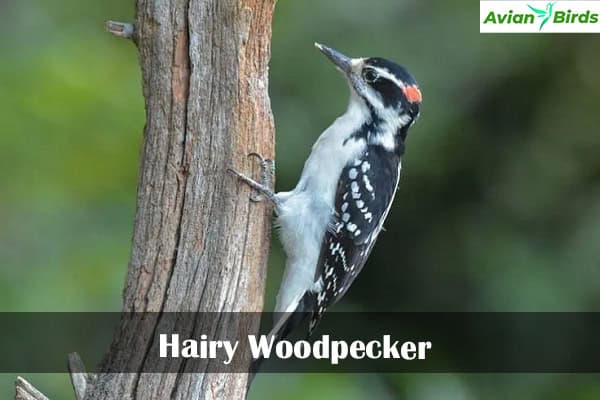
Identification
Hairy Woodpeckers have striking features. Males have a red patch on their heads, while females have black wings without red. They are about 9¼ inches long, bigger than Downy Woodpeckers. Their long, chisel-like bills are almost as long as their heads.
They have white spots on their wings and tail feathers, especially in the East. Northern birds are bigger, with a brown and black pattern in the Pacific Northwest.
Diet and Foraging Habits
Hairy Woodpeckers mainly eat wood-boring insects from trees. They also go to burned areas for these insects. They eat sap and fruits when they can.
This flexible eating helps them live in many places.
Where to Find This Bird
Look in woodlots, suburbs, parks, and cemeteries to find Hairy Woodpeckers. They like burned forests and areas with bark beetles. In northeastern Wisconsin, they stay all year.
| Aspect | Details |
|---|---|
| Size | Approximately 9¼ inches |
| Male Identification | Red back patch and extensive white wing spotting |
| Female Identification | Black wings, no red head |
| Diet | Primarily wood-boring insects, sap, fruits |
| Habitat | Woodlots, suburbs, parks, forest edges, burned areas |
| Year-Round Presence | Northeastern Wisconsin |
| Territory Size | May defend areas no larger than 100 feet in diameter |
3. Northern Flicker
- Scientific Name: Colaptes auratus
- Size: 30–36 cm (12–14 in)
- Weight: 90–150 g (3.2–5.3 oz)
- Lifespan: Up to 9 years in the wild
- Diet: Primarily ants and beetles, as well as seeds and fruits
The Northern Flicker is a striking woodpecker with unique traits. It has a brown-barred back and spotted belly. Males have red markings and a black “mustache.” It’s as big as an American Robin, making it easy to spot.

Identification
Look for two color forms: red-shafted and yellow-shafted. The red-shafted form is found in western North America. Unlike other woodpeckers, it forages on the ground.
Diet and Foraging Habits
The Northern Flicker eats ants and beetles. Its long tongue helps it get insects from the soil. It forages on open ground and fights for territory or mates.
Where to Find This Bird
Find Northern Flickers in forest edges, open woodlands, parks, and fields. They’re common during migration. Watch for them from late March to early May. Nesting is from early May to mid-June.
4. Pileated Woodpecker
- Scientific Name: Dryocopus pileatus
- Size: 38–49 cm (15–19 in)
- Weight: 250–400 g (8.8–14.1 oz)
- Lifespan: Up to 12 years in the wild
- Diet: Primarily wood-boring insects
The Pileated Woodpecker is a big bird in North America. It stands out because of its size and bright colors. Also, It has a red crest and black feathers with white stripes.

It makes big holes in trees. These holes help it find food and make a home.
Identification
The Pileated Woodpecker is easy to spot. It has a big body and a bright red crest. It also makes loud drumming sounds.
These sounds help it claim its territory and find a mate. You can see these birds in many places in Wisconsin.
Diet and Foraging Habits
Pileated Woodpeckers eat ants and beetles. They make big holes in trees to find food. These holes can be up to three inches wide.
They like trees that are dying or dead. This helps the forest grow and gives homes to other animals. Watching them is fun because they are very agile.
Where to Find This Bird
Wondering where to find Pileated Woodpeckers? Look in places like Faville Woods and the Kettle Moraine State Forest. They like areas with big trees for nesting.
Watch for their tree holes and how they move. It’s a great way to see them in their natural home.
Must To Read: Woodpeckers Of Ohio
5. Red-bellied Woodpecker
- Scientific Name: Melanerpes carolinus
- Size: 23–25 cm (9–10 in)
- Weight: 70–100 g (2.5–3.5 oz)
- Lifespan: Up to 12 years in the wild
- Diet: Insects, fruits, nuts, and seeds
The Red-bellied Woodpecker is a joy to see in Wisconsin. It’s known for its bright appearance and friendly manner, and bird lovers really enjoy watching it.

Look for a grayish face and black-and-white stripes on its back. Males have a bright red crown. They are about 9.5 inches long and have a sleek, round head.
Identification
Red-bellied Woodpeckers have interesting looks and ways. Males have a bright red crown and nape, while females have a red nape but no crown. Young birds are not as colorful.
They fly in a special way, hopping on branches. This makes them fun to watch as they search for food.
Diet and Foraging Habits
These birds eat a lot of different things. Also, They like insects, fruits, seeds, nuts, and even small animals. They visit backyard feeders, especially for suet in cold weather.
They have a special tongue that helps them get food from bark. This helps them survive.
Where to Find This Bird
Red-bellied Woodpeckers live in many places. They like woodlands, urban forests, and suburbs. They are easy to find in Wisconsin.
The Lake Mills Ledge and Faville Woods are great places to see them. They like high places to stay warm in winter.
6. Red-headed Woodpecker
- Scientific Name: Melanerpes erythrocephalus
- Size: 22–26 cm (8.7–10.2 in)
- Weight: 70–100 g (2.5–3.5 oz)
- Lifespan: Up to 9 years in the wild
- Diet: Insects, fruits, nuts, and seeds, often foraging on the ground.
The Red-headed Woodpecker is a bird known for its bright red head and shiny black back. It has a white belly and is about 9 inches long. Knowing how to identify and understand these birds can make birdwatching more fun.

Identification
Adult Red-headed Woodpeckers of Wisconsin have a bright red head and white belly. Their black backs have big white patches. Young birds have gray-brown heads with white patches and black spots.
Their calls are sharp and different from other woodpeckers. They are between the size of a robin and a crow. This makes them easy to see in nature.
Diet and Foraging Habits
Red-headed Woodpeckers eat insects, fruits, and seeds. They catch insects in midair and hunt on the ground. They also store food for later.
This helps them live in different places like pine savannahs and open forests. Saving their homes and food is key to their survival.
| Characteristic | Details |
|---|---|
| Size | Approximately 9 inches long |
| Distinctive Coloration | Bright red head, white underparts, black back |
| Feeding Behavior | Catching insects in midair, ground hunting, fruit and seed consumption |
| Habitat | Pine savannahs, open forests, agricultural treerows |
| Population Status | Considered a Priority Species by Wisconsin Bird Conservation Initiative |
7. Yellow-bellied Sapsucker
- Scientific Name: Sphyrapicus varius
- Size: 18–22 cm (7–8.7 in)
- Weight: 50–100 g (1.8–3.5 oz)
- Lifespan: Up to 6 years in the wild
- Diet: Primarily sap from trees, along with insects and fruits.
The Yellow-bellied Sapsucker is a unique bird in the woodpecker family. It has distinct features that make it easy to spot. Knowing how to identify and understand its characteristics can make birdwatching more fun.

Identification
The Yellow-bellied Sapsucker has a black-and-white face with bold stripes. It has a warm yellowish belly and a red cap on males. It’s about 7.5 to 8.3 inches long, between the Downy and Hairy Woodpeckers in size.
Both males and females have red foreheads, and males also have a red throat. They live in forests near water with trees like aspen, birch, and maple. They like to nest in dead hardwood trees.
These birds drill holes in tree bark to extract sap. They prefer sap from hardwoods like maple, which attracts insects like ants, spiders, and wasps.
Yellow-bellied Sapsuckers are known for their migration. They are the only North American woodpecker that truly migrates. In early October, they migrate through southern Wisconsin. Some stay in Wisconsin, while others go as far as Costa Rica.
| Characteristic | Description |
|---|---|
| Size | 7.5 to 8.3 inches long, between Downy and Hairy Woodpecker |
| Coloration | Black and white face, yellowish underside, red cap on males |
| Nesting Preference | Cavities in dead hardwood trees |
| Feeding Behavior | Drills neat holes for sap from hardwood trees |
| Migration | True migration pattern; peak migration in early October |
Woodpeckers in Wisconsin: A Diverse Community
Wisconsin’s rich ecosystems are home to a lively woodpecker community. This community includes many woodpecker species. Each bird is crucial for the health of Wisconsin’s forests.
Woodpeckers drum to mark their territory as songbirds sing. This drumming is a key part of their behavior.
Woodpeckers have special feet that help them climb trees. They use these feet to find food by pecking into tree bark, and their ability to hear insects under the bark is key to this process.
These birds are important for controlling pests, like the Emerald Ash Borer Beetle. They help keep forests healthy.
Dead ash trees are vital for woodpeckers. They provide homes for these birds. Saving these trees is important for many wildlife species.
In winter, woodpeckers add color to the snowy landscape. They remind us of nature’s beauty and strength.
Some woodpecker species, like the red-headed woodpecker, are declining. In Wisconsin, their numbers have dropped by 60-70%. But, efforts to restore native plants and manage habitats are helping.
Learning about woodpeckers in Wisconsin helps us appreciate wildlife. It also encourages us to keep working on conservation.
Other Rare Woodpeckers You Might Spot
Wisconsin is home to many woodpeckers, but some are rare. You might see the Black-backed and American Three-toed Woodpeckers. They live in northern woodlands. Knowing where to look can help you spot them.
The Black-backed Woodpecker is about 9.1 inches long. It has a black back, making it stand out. They like forests with dead trees, where they find insects. Seeing this woodpecker takes patience because they are not common.
The American Three-toed Woodpecker is 8.3 inches long. It has three toes, helping it climb. They are found in forests recovering from fires. There, they look for beetle larvae under dead tree bark.
| Woodpecker Species | Length | Distinctive Features | Preferred Habitat |
|---|---|---|---|
| Black-backed Woodpecker | 9.1 inches | Striking black back | Coniferous forests with dead trees |
| American Three-toed Woodpecker | 8.3 inches | Three toes, unique climbing ability | Areas recovering from forest fires |
Learning about these rare woodpeckers in Wisconsin prepares you for birdwatching. Look for these interesting birds as you explore Wisconsin’s diverse habitats.
Conclusion
Woodpeckers in Wisconsin show the state’s wildlife in full color. Each bird is special and plays a key role in nature. Knowing about their habits and homes is crucial for saving them.
Watching woodpeckers in cities or forests is amazing. You see how they live and adapt. For example, the Pileated Woodpecker can hit trees hard without getting hurt.
Keep watching birds and learning how to help them. It is important to save places like oak savannas. By supporting restoration or learning about nesting, you can help protect Wisconsin’s birds.
Read More🐦Related Articles:
- Woodpeckers in Texas
- Kingfisher Bird
- Types Of Hawks
- Biblical Meaning Of Dead Birds
- Can Ducks Eat Cucumber Safely?
- Two Birds on a Wire Meaning
Frequently Asked Questions
Q1. What woodpeckers are from Wisconsin?
Wisconsin is home to several woodpecker species, including the Downy Woodpecker, Hairy Woodpecker, Northern Flicker, Red-bellied Woodpecker, and Pileated Woodpecker.
Q2. Do Wisconsin woodpeckers migrate?
Most woodpeckers in Wisconsin are non-migratory, but some, like the Northern Flicker, may migrate south during winter.
Q3. What kind of bird has a red head in Wisconsin?
The Red-bellied Woodpecker and the male Northern Flicker both have red on their heads, with the Flicker having a red “mustache” mark.
Q4. Which is the most common woodpecker?
The Downy Woodpecker is considered the most common woodpecker in Wisconsin.

